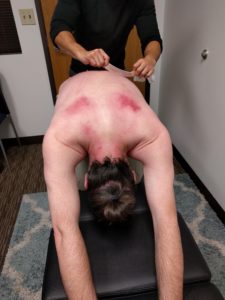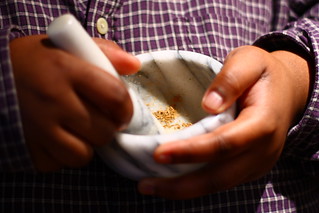
You Are What You… Ah, Californians. We are known for our obsessive obeisance to our bodies. The derisive label of ‘fruits and nuts’ expanded to ‘crunchy granola’ as we became known for vegetarianism, macrobiotics, yoga, gluten-free everything, veganism… and alkaline, “live” and raw water, which appears to be the latest (completely made-up for marketing to the giardia unwary) thing. Our state has become synonymous with free range, grass-fed, organic everything, and the gospel of California Wellville dovetails beautifully with the pinched ideals of traditional American Puritanism, that of perfection, rigidity, guilt, and blame: if you’re sick, it’s really your own failings. You should have done better; you could have saved yourself. After all, I TOLD YOU HOW. Don’t you know, you are what you eat???
If you feel this is gross exaggeration, just talk to anyone who has had cancer, or has a child who struggles with attention deficits or hyperactivity or, worse, falls anywhere along the autism spectrum. Each of them will have a story of some earnest and well-meaning soul who suggested alfalfa pills, acupuncture, or Atkins, chided them for not adhering to a plant-based diet, or insisted that it was all of the dyes / carbs / caffeine/ vaccinations which was to blame. Those folk generally leave the people they mean to help feeling defensive, defeated, battered, and dismayed. Truth is, we all just want to feel better, to help each other feel better. Too often, though, we attach a moral price tag to our health choices, and we embrace our beliefs like they are a true religion.

Put Your Money Where Your Mouth… We’re less susceptible to the lure of the quick cure, as we do make a huge effort to read up on research and keep current with medical stuff, as we’re required to do by the doctor we’ve seen for the last five years. Since December, we’ve been seeing a myo-kinesthesiologist twice a month, and going through some (fairly brutal) body corrective exercises, stretches, and adjustments to help T deal with the diminished mobility due to her autoimmune disorder, and with issues surrounding D’s degenerated disc – two things which are annoying, but just a feature of our lives. In consequence, some months ago had a conversation with an acquaintance on topics of health wherein she insisted that diabetes could be cured with exercise and a vegan diet, and that we could be pharmaceutical-free if we’d only change our diet. When D pushed back, she reminded him that his body was a temple, that he was what he ate, and that, in essence, if he failed to follow her prescribed way of living, subsequent illness was his own fault. It’s always awkward when someone asking how you’re doing is a pit trap lined with sharpened sticks, isn’t it? Predictably (as those who know him will agree) the next day D said, “Let’s visit a cannabis dispensary!” This suggestion was also, equally predictably, followed by a “WHAT!?” and a very long wrangling discussion indeed.
Take It With A Pinch Of… Despite both of us having the knowledge that a prescription opiate drug user is morally no better than a cannabinoid user, and that both drugs have legal medical uses (though only one is quite as open to fatal abuse and overdose), the idea of cannabis was still hard for T. to get her head around. The moral price tag placed on drug use in this society is real, especially for those of us raised in conservative faiths, or in those faiths which observe dietary strictures. (It’s double-jeopardy for Mormons, Jews, Muslims, Seventh-day Adventists, and some Orthodox Christians.) Then, there remains the historic stigma surrounding people of color and cannabis use, to the extent that when T mentioned D’s desire to an acquaintance, their first response was to ask if she’d next be knitting Rastafarian caps… not moving to Haight Street with the hippies or attending the Coachella festival, both places typically known for their majority white cannabis users, but knitting Rastafarians caps, referencing black Jamaicans who use cannabis as part of a poorly regarded sociopolitical/religious movement. It wasn’t any wonder that once the decision was made, T. still elected to stay in the car.
For those now alarmed about our ethics, it may be important to note that first, the human body actually has an endocannabinoid system, through which it produces its own cannabinoids (which is responsible for chocolate euphoria, natch), and, second, that cannabis derived cannabidiol (CBD) is similar to the THC found in marijuana, except it’s non-psychoactive, and does not produce a euphoric high, containing, as it does, insufficient THC to do so. (Though cannabis is highly cultivated and hybridized, of the three main types, only one has that euphoric ingredient; the other is used to make industrial-use hemp rope and contains the pain-relieving CBD, while the third simply makes a mediocre ground cover, apparently.) Animal studies of cannabinoid topicals show reduced pain in animals with inflammation or neuropathic pain. Topical creams containing CBD have been proven effective pain-relievers in humans, too (though the joint 2017 study by The National Academies of Science, Engineering and Medicine doesn’t have as much information on how and why and for how long as one might want). Finally, history reveals that the criminalization of cannabis use, and the sweeping generalizations about its effects on certain populations were purposeful — a targeted, deliberate second step extending the incarceral state of African Americans begun with the Atlantic slave trade… all this to say, some of our reflexive prejudices surrounding cannabis use have been highly manipulated, but for now, we’ll put our sociologist’s hats aside and get on with the story.
It’s a Piece of Cake…Despite the current legality of cannabis for medical and recreational use, and despite the hundreds of apparently legal products on the market for the last several years, it was clear that many of the people sidling up to the nondescript metal door just past the corner of Apple Street still also viewed their visit as a wildly transgressive act. T observed with wry amusement that there were quite a few car-sitters with her, with several other people standing across the street and surveying the other customers, or waiting outside for a friend to arrive before going in. Some scuttled in, guiltily, while the bros swaggered and wink-nudged one another like ninnies. The range of humanity from 21 – 80+ was vast, though the majority was older middle and college-aged. Affluently dressed, or in tracksuits, there was a steady stream of business. Inside, the set-up was like an old fashioned pharmacy, with a long, high counter from behind which the workers stood to help customers individually. Items pointed to and described were brought from behind the counter, while customers lingered to ask anxious questions (How much should I take? What will happen?); some eyeing the guards (who were checking ID at the door and loitering with intent, every five feet) nervously.
As we pulled away with our purchase (a topical cream), T. read the ingredients, which proudly claimed to be “all natural.” (Yes, well.) With the exception of CBD, the ingredients could have been found in any high-end massage cream – sweet almond oil, plant and nut extracts, emu oil(!), menthol, Vitamin E, aloe, Shea butter, arnica, and essential oils were hardly surprising. The label listed the preparation as good for back pain, and so, after showering in preparation for bed, we applied the cream to a limited area on D’s back, and on T’s neck, with the expectation that we would wait an hour to try another spot, or see if we needed to reapply.
In A Nutshell… CBD works by increasing the body’s natural endocannabinoids, decreasing its inflammatory response, and desensitizing its pain receptors. We didn’t know what to expect, having read very mixed reviews for the myriad creams on the market (we used the Sacramento lab affiliated, and more expensive Carter’s Aromatherapy Cream). For D’s back, the pain relief was jaw-droppingly near-instantaneous. Because T had massaged it in, he hadn’t been sure (when you’re putting pressure on a painful area, it’s hard to notice when it quits hurting) of this, so he simply dabbed, then smoothed the cream into T’s neck. Within minutes, the pain there was also simply erased. We experimented on other areas, and found that for use in smaller joints (fingers, wrists) the topical cream was very responsive. For larger joints (hips) there was minimal pain interruption (we didn’t have knee pain, so depending on joint size and issue, that may vary). CBD only penetrates to work within the first centimeter of skin – if the inflicted area is close to surface, all well and good, but if it’s surrounded by bone or many ligaments, an Advil might better do the trick.
The faintest indication of pain returned almost five hours later in D’s back, and roughly about the same time for T’s neck, though both experienced a much more reduced intensity of pain, an effect which lasted over twelve hours before the pain ramped up to resume to its normal pitch.
So now for the first time since being born here, T feels very Californian, having used her first cannabis-derived, wholistic, all-natural, yadda, yadda, yadda. We entered into this… excursion, mainly as an exercise in opposition (not gonna lie, some of us are still defiant adolescents at heart sometimes), but were made hopeful for the applications of science to use these compounds to alleviate die-ease – not just in terms of neuromuscular pain, but there are applications for cystic acne and widespread eczema (apparently CBD is an antioxidant), chemotherapy-related nausea and digestive issues, as well as anxiety disorders, too. As our particular issues continue to be a part of our lives, we’re grateful for treatment that doesn’t unduly disrupt the body more than necessary. For now, “You are what you eat” is true enough that it can be extended to a necessary caution toward what we take, too. Right now, we’d rather throw in our hand with CBD than heavier painkillers, and avoid joining the statistics of those succumbing to opiate addiction.
Here’s to doing all we can, in the land of crunchy granola folk, to continue to be well.

I’m very interested to hear that you have found some relief with this. C and I did some talking and research on this while in Colorado, and that is my one regret of not stepping foot in one of those places and finding a patch or cream with CBD that C could try for the neuropathy.
@Lori… well, you now officially have an excuse to come and visit. ☺
It’s hard to want to go into some of the dispensaries, not all of them look …familiar? It was weird, but I’m glad we did it.
Enjoyed this–I am so behind in reading your posts, so it is with coffee this morning (my third and very atypical cup) that I am catching up. Glad to hear of the relief it provides. Honestly, I supposed I never realized that anything but smoking it was possible, and that isn’t anything I’d ever consider. A cream is a different subject all together so thank you for explaining it so thoroughly. Now, to see if I might coerce my husband to consider it. Alas, both of us are the type to sit in the car and wait outside so we’ll have to find someone who will brave the shop on our behalf!